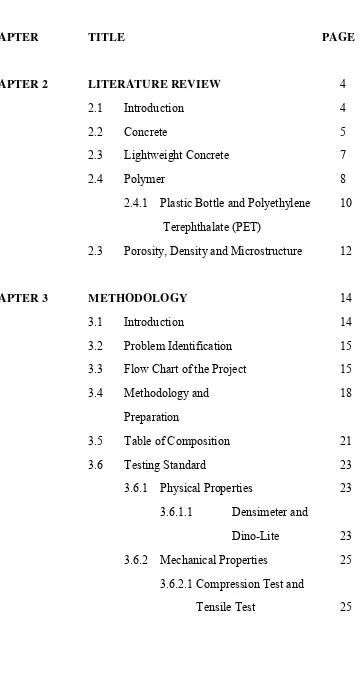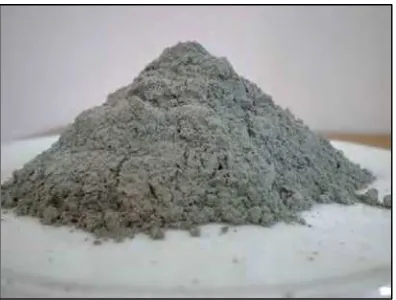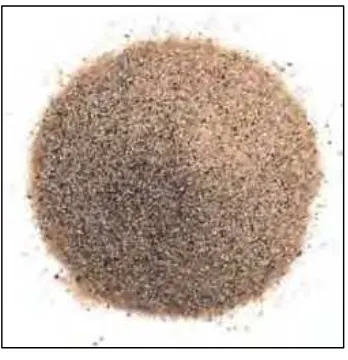APPLICATION OF PLASTIC BOTTLE WASTE ON LIGHTWEIGHT COMPOSITE STRUCTURE MATERIALS
NURUL ASYILAH BINTI ZAKARIA
ii
DECLARATION
“I hereby declare that the work in this report is my own except for summaries and quotations which have been duly acknowledged”
Signature : ………..
Author : ………..
iii
SUPERVISOR DECLARATION
“I hereby declare that I have read this thesis and in my opinion this report is sufficient in terms of scope and quality for the award of the degree of Bachelor of
Mechanical Engineering (Design and Innovation)”
Signature : ………
Supervisor : ……….
iv
Special for
v
ACKNOWLEDGEMENT
Alhamdulillah, I praise The Almighty, Allah for giving me the chance to finish up this Projek Sarjana Muda 2 report. I would like to thanks my supervisor, Dr. Mohd Ahadlin Bin Mohd Daud. He helped me a lot during this two semesters, gave supported, guided and cheering me up.
I love to say thank you to my parents for the continuous support given to me morally or technically. Next, thank you to all my friends for their cooperation and good luck to all of you too. I would like to mention my beloved friends whom I called them as Saujana9 and The Presidents. Without them, I might be dying for ideas and hopes.
vi
ABSTRACT
This report presents the work on plastic bottle as an alternative material in construction as lightweight composite structure material. The alternative construction such as in wall partition, fence, pavement and pedestrian pathway. The conventional concrete or the common concrete are well known to be high in weight, low resistant to humidity and corrosion and higher heat conductivity. A study in this project was conducted to determine if Polyethylene Terephthalate (PET) is suitable to resolve this problems as an aggregate in lightweight concrete. Physical and mechanical properties of the lightweight PET aggregate concrete with various composition has been determined by analysis based on result obtained from relevant tests. The tests were based on regulation of American Society for Testing and Materials (ASTM) which is the test of the PET aggregate can been accepted if density below than
1800kg/m3. The Polyethylene Terephthalate (PET) nowadays, based on the recently
vii
ABSTRAK
viii
TABLE OF CONTENT
CHAPTER TITLE PAGE
DECLARATION II
SUPERVISOR DECLARATION III
DEDICATION IV
ACKNOWLEDGEMENT V
ABSTRACT VI
ABSTRAK VII
TABLE OF CONTENT VIII
LIST OF TABLES XI
LIST OF FIGURES XIII
LIST OF SYMBOLS XVII
LIST OF APPENDICES XVIII
CHAPTER 1 INTRODUCTION 1
1.1 Background 1
1.2 Problem Statement 2
1.3 Objective 2
ix
CHAPTER TITLE PAGE
CHAPTER 2 LITERATURE REVIEW 4
2.1 Introduction 4
2.2 Concrete 5
2.3 Lightweight Concrete 7
2.4 Polymer 8
2.4.1 Plastic Bottle and Polyethylene 10
Terephthalate (PET)
2.3 Porosity, Density and Microstructure 12
CHAPTER 3 METHODOLOGY 14
3.1 Introduction 14
3.2 Problem Identification 15
3.3 Flow Chart of the Project 15
3.4 Methodology and 18
Preparation
3.5 Table of Composition 21
3.6 Testing Standard 23
3.6.1 Physical Properties 23
3.6.1.1 Densimeter and
Dino-Lite 23
3.6.2 Mechanical Properties 25
3.6.2.1 Compression Test and
[image:9.595.133.495.72.746.2]x
CHAPTER TITLE PAGE
CHAPTER 4 RESULT 27
4.1 Microstructure Observation 27
4.1.1 Microscopic Observation under
50X and 200X Magnification 27
4.2 Physical Properties 38
4.2.1 Dimension and Density of
Specimen 38
4.2.2 Water Absorption 45
4.3 Mechanical Properties 46
4.3.1 Compression Test 46
4.3.2 Tensile Test 47
CHAPTER 5 DISCUSSION 48
5.1 Physical Properties 48
5.2 Mechanical Properties 55
5.2.1 Compression Test 55
5.2.2 Splitting Tensile Test 58
5.3 Factors That Manipulate the Compression
and Tensile Test 61
CHAPTER 6 CONCLUSION AND
RECOMMENDATATION 62
6.1 Conclusion 62
6.2 Recommendation 64
REFERENCES ` 66
xi
LIST OF TABLE
NO TITLE PAGE
2.1 Table of resin codes 9
3.1 Table of Composition of Plastic Bottle and Concrete 21
Mixture
3.2 Table composition of conventional concrete 22
4.1 Dimension and Density of sample A1 39
4.2 Dimension and Density of sample A2 39
4.3 Dimension and Density of sample A3 40
4.4 Dimension and Density of sample B1 40
4.5 Dimension and Density of sample B2 41
4.6 Dimension and Density of sample B3 41
4.7 Dimension and Density of sample C1 42
4.8 Dimension and Density of sample C2 42
4.9 Dimension and Density of sample C3 43
4.10 Dimension and Density of conventional concrete 43
xii
NO TITLE PAGE
4.12 Water absorption percentages of all specimens 45
4.13 Results data for compression test of all specimens 46
4.14 Results data of splitting tensile stress of all specimens 47
5.1 Data results for density and water absorption test along 49
with compositions of specimens
5.2 Table of compression strength (MPa), maximum load (kN) 55
and composition of all specimens.
5.3 Table of tensile strength (MPa), maximum load (kN) and 58
xiii
LIST OF FIGURE
NO TITLE PAGE
2.1 Fly Ash 5
2.2 River Sand 6
2.3 Water 6
2.4 Plastic Bottles as the Example of Pet Product 10
2.5 Polyethylene Terephthalate (PET) Chemical Formula 11
2.6 Polyethylene Terephthalate (PET) Manufacturing Process 12
3.1 Problem Identification Flow 15
3.2 The flow chart of the overall project 16
3.3 Flow chart of the project manufacturing process 18
3.4 Illustration of the Mixture Project Flow Chart 19
3.5 Cable tie that used to tight hold the PVC pipe. 20
3.6 PVC pipe that used in this project 20
3.7 The Electronic Densimeter 24
3.8 Dino-Lite for magnification 24
xiv
NO TITLE PAGE
4.1 Microstructure of 50X magnification (Sample A1; 10% PET,
10% additive, 40% sand) 28
4.2 Microstructure of 200X magnification (Sample A1; 10% PET,
10% additive, 40% sand) 28
4.3 Microstructure of 50X magnification (Sample A2; 11% PET,
9% additive, 40% sand) 29
4.4 Microstructure of 200X magnification (Sample A2; 11% PET,
9% additive, 40% sand) 29
4.5 Microstructure of 50X magnification (Sample A3; 12% PET,
8% additive, 40% sand) 30
4.6 Microstructure of 200X magnification (Sample A3; 12% PET,
8% additive, 40% sand) 30
4.7 Microstructure of 50X magnification (Sample B1; 7% PET,
8% additive, 45% sand) 31
4.8 Microstructure of 200X magnification (Sample B1; 7% PET,
8% additive, 45% sand) 31
4.9 Microstructure of 50X magnification (Sample B2; 8% PET,
7% additive, 45% sand) 32
4.10 Microstructure of 200X magnification (Sample B2; 8% PET,
xv
NO TITLE PAGE
4.11 Microstructure of 50X magnification (Sample B3; 9% PET,
6% additive, 45% sand) 33
4.12 Microstructure of 200X magnification (Sample B3; 9% PET,
6% additive, 45% sand) 33
4.13 Microstructure of 50X magnification (Sample C1; 5% PET,
5% additive, 50% sand) 34
4.14 Microstructure of 200X magnification (Sample C1; 5% PET,
5% additive, 50% sand) 34
4.15 Microstructure 50X magnification (Sample C2; 6% PET,
4% additive, 50% of sand) 35
4.16 Microstructure 200X magnification (Sample C2; 6% PET,
4% additive, 50% of sand) 35
4.17 Microstructure of 50X magnification (Sample C3; 7% PET,
3% additive, 50% sand) 36
4.18 Microstructure of 200X magnification (Sample C3; 7% PET,
3% additive, 50% sand) 36
4.19 Microstructure of 50X magnification of pure concrete 37
4.20 Microstructure of 200X magnification of pure concrete 37
5.1 Comparison of density, water absorption and PET percentages
xvi
NO TITLE PAGE
5.2 Comparison of density, water absorption and PET percentages
of group B 51
5.3 Comparison of density, water absorption and PET percentages
of group C 52
5.4 Comparison of density, water absorption and PET percentages
of all specimens 53
5.5 Voids happened outside the specimens 54
5.6 The graph of compressive strength of all specimens 56
5.7 The graph of stress against strain of compression test 57
5.8 The graph of splitting tensile strength of all specimens 59
xvii
LIST OF SYMBOLS
� = density, kg/m3
� = mass, kg
� = volume, m3
r = radius, mm
d = Diameter of Specimen, ��
� = Pi
h = height, mm
k� = kilo Newton
xviii
LIST OF APPENDICES
NO TITLE PAGE
1 Gantt chart for PSM 1 70
2 Gantt chart for PSM 2 71
3 INSTRON machine used for this project 72
4 Densimeter used for this Project 72
5 Blue Hill shows the graph data 73
6 The preparation of molds and shredded plastics bottles waste 73
7 The PVC pipes were prepared for desired mold dimension 74
8 The plastics bottles was added into the composition of concrete 74
9 During using the INSTRON machine 75
10 The position of specimens during compression test 76
11 The position of specimens during splitting tensile test 76
12 The conventional concrete rupture after splitting tensile test 77
13 The microstructure observation 77
14 The density test 78
15 The example of compression test result data and graph 79
1
CHAPTER 1
INTRODUCTION
1.1 BACKGROUND
Lightweight materials are importance for many countries for lots of reasons. Many research proves that, lightweight is a cross cutting for crucial performance such as energy, transportation and generals products. Lightweight material generally can be divided into a few groups, which are:
Metal
Composites
Polymers
2
Concretes were used since ancient Romans, to prove, Egyptians also used to build the one of the Seven Wonders, pyramid. To conclude, concrete is the basic unit of building. As time flees, many building are built for high population demanding.
Since thousands of years ago, the environment has become a part of our lives. However, when the discoveries of science and technology get more attentions and become our lifestyles, environment is omitted. Pollutions nowadays not become our priority to protect.
1.2 PROBLEM STATEMENT
There are tons of plastics that ended up as wastes. For example is the plastic bottle. Plastic bottle waste nowadays is considered to be a major problem. This is an environmental issue as its takes thousand years to bio-degrade, involves processes either to recycle or to reuse and if incinerated, they will produce toxic fumes. This will affect human health beside increase the world temperature. Hence, this project studies the proper way to reuse the plastic bottle waste.
1.3 OBJECTIVE
The main objective in this project:
a. To perform a study in concrete for manufacturing process by
using Polyethylene Terephthalate (PET), plastic bottle as an aggregate.
3
1.4 SCOPE OF PROJECT
The scope of this project is concerned on the material used as alternative aggregate in lightweight concrete along with the classification of that as follows:
Materials being used in the composition of lightweight concrete in this
project is Polyethylene Terephthalate (PET), sand, cement, additive (fly ash) and water.
The microstructure on the lightweight concrete structure.
Analyse the mechanical properties of the lightweight concrete with different composition for compression strength and tensile strength.
Analyse the physical properties of the lightweight concrete along with
4
CHAPTER 2
LITERATURE REVIEW
2.1 INTRODUCTION
5
2.2 CONCRETE
Concrete can be described as a universal material. Peter (2010) finds concrete has been and continue to be a great for all types of constructions throughout the world and has been described as the most important construction material. Concrete is a mixture of cement, sand (aggregates) and water. Cement is an essential components because when it is hydrated or no more water excess, its binds the aggregates together to form the hard, strong and useful. Sometimes, fly ash (Figure 2.1) is added as an additive. The type of sand usually used for construction is the river sand. To make a strong concrete, the ratio of the materials should be correct.
[image:23.595.221.419.492.642.2]The strength, toughness and other characteristics of the concrete is depending on the mixing composition, the method used and other control processes. However, for country like Malaysia, India, Indonesia and others, the normal strength of concrete is very much different from the west. This is because of the temperature and air humidity.
6
Figure 2.2: River sand.
From Figure 2.2, river sand is used in this project as aggregates. Aggregates are inert granular materials such as sand, gravel or crushed stone that, along with water and cement, are essential ingredient in concrete. There are two types of aggregates, fine and coarse. Aggregates strongly influence concrete’s properties as stated in Cement Concrete Basic. Figure 2.3 shows the water used.
Figure 2.3: Water.
[image:24.595.211.428.434.617.2]

